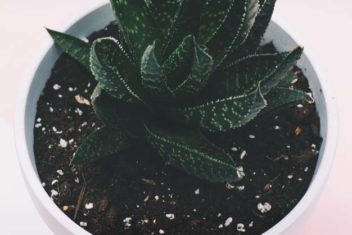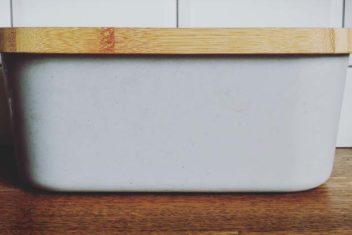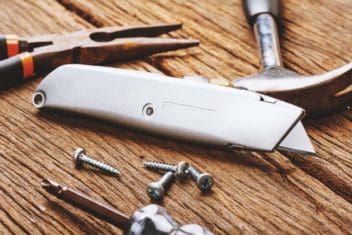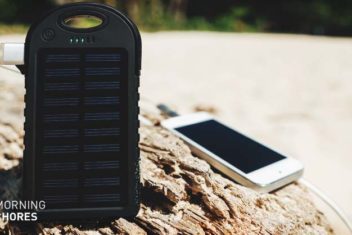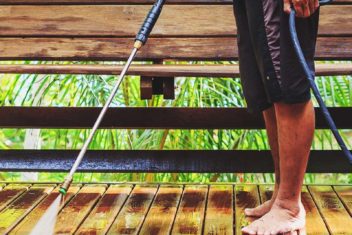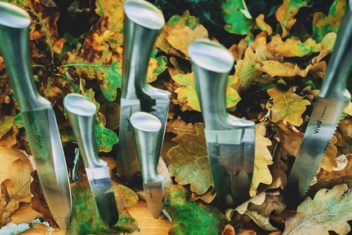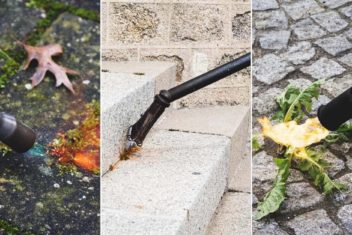Most people want to have a beautiful lush lawn. It’s a sign that you take care of your property and are doing things right! But, how do you actually achieve it? The secret trick to having a green lawn is to figure out what lawn fertilizer is best for your lawn and when to apply it.
Both of these depend on different things. Geography, type of lawn and household needs all play a part in finding the right fertilizer. Here are some important tips to get the beautiful lawn you want.
The 5 Best Lawn Fertilizers
- Scotts Turf Builder Lawn Food
- Miracle-Gro 1001834 Water Soluble 5 lbs Lawn Food
- Simple Lawn Solutions Extreme Grass Growth Lawn Booster (Our Top Pick)
- GreenView Lawn Food
- Milorganite 0636 Organic Nitrogen Fertilizer
Our Top Pick for the Best Lawn Fertilizer
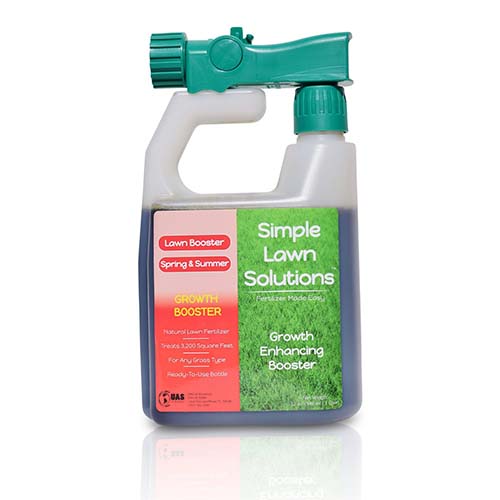
Our top pick for the best lawn fertilizer is the Simple Lawn Solutions Extreme Grass Growth Lawn Booster.
Extreme Grass Growth Lawn Booster from Simple Lawn Solutions stands out from the rest. Not only is it appropriate for established lawns, but it is also good for new lawns. This makes it one of the most well-rounded lawn fertilizers available.
Check the price on AmazonUnderstanding What Fertilizer Is
Fertilizer is made from three nutrients and filler. The three nutrients are:
Nitrogen
Nitrogen is a protein apparent in every plant, so it stands to reason supplementing it would help spur the growth process. Not only does it help with that though, but it also can help plants fight off damaging pests. This is one of the main things that promote the lush green color in your grass.
Phosphorous
Phosphorous is an ingredient that gives plants their ability to convert nutrients into growth-agents. Fertilizers are rife with nutrients, but this one allows those nutrients to foster a robust root.
If you have a very new patch of grass and want to encourage growth, fertilizer with high phosphorous can help you do that. On the other hand, if you have grass that has been around for decades, the best fertilizer likely will have much less.
Potassium
Potassium is considered to be second to nitrogen when it comes to spurring growth in plants. It is referred to as the “quality nutrient” for good reason; the amount affects the plant’s size, color, and shape. If you see “healthy-looking” grass, likely it is because of its spot-on potassium. In addition, it also helps plants develop resistance to cold and drought.
Now that you understand what makes up a fertilizer, let’s look at how it is marketed.
What Type of Grass Do You Have?
Figuring out the type of grass you have can be a key step in understanding what type of lawn fertilizer to purchase. As a basic rule, if you are in the western or southern areas of the country you have “warm-season grass.” This includes species such as Bermuda, Centipede, Zoysia or Bahia.
These types of grasses need anywhere from 3 to 4-pounds of lawn fertilizer per 1000-square-feet, annually.
On the other hand, the Midwest and Northeastern parts of the country have what is called “cool-season grass.” This includes species such as Kentucky bluegrass, Rye, and Tall Fescue. This grass needs anywhere from 1 to 2-pounds of lawn fertilizer per 1000-square-feet, annually. It’s a sturdier grass and can withstand more, so it needs less fertilizer-care.
Types of Lawn Fertilizer
In general, when you visit a garden store, you’ll find three different types of lawn fertilizer: organic, granular and water-soluble. Organic fertilizers are all-natural and can be made at home. If you have ever had a compost, you had this type of fertilizer. It breaks down over time and slowly releases nutrients back into the soil.
This soil then feeds the lawn. Granular styles of fertilizer come in time-release formulas and allow you to control when you want your lawn to be fed. Finally, water-soluble fertilizers are quick-release so the benefits are apparent almost immediately. They also are usually ammonium-based to help grass truly absorb the solution.
When you are picking fertilizer, consider things like how you want to apply it, how often you want to apply it, how much your lawn needs, how available you are to care for your lawn. Things like this can help you make the wisest decision for your specific application. For example, if you know you can be around throughout the spring/summer to watch your grass, water-soluble fertilizers may work best for you.
On the other hand, if you go out of town for a few weeks during summer and won’t be available, time-release granules may be the best solution.
Be sure to note any other problems you have with your lawn. Fertilizers can include agents that ward off bugs/pests and eliminate weeds like chickweed, crabgrass or black clover. You also can find fertilizers with added ingredients that promote quick-growth. You’ll see results right away with these.
How to Estimate Fertilizer Needs
The easiest way to estimate your fertilizer needs is to measure your surface area of grass. Take a measurement of width and length to calculate square footage. If you can’t do this, then strategic guessing is your next best option.
In general, every eight steps is approximately 10-feet of space. Try walking your lawn from side-to-side on the length and width. You can at least get a basic idea of how much space you need to cover. For a visual guide, think of a standard tennis court that is 36-feet by 78-feet.
For misshaped lawns, consider these calculations:
- Triangles: Figure out the length and width of the triangles. Multiply the two numbers together and divide by two. This will give you the surface area.
- Circles: Find the center of the circle and walk out to the edge. Multiply this number by 3.14 to get the surface area.
When you’re done with your calculations, add them all together to get the full surface area of your lawn.
When to Fertilize
When it comes to knowing when to fertilize your lawn the rule of thumb is, earlier is better. You want to get the proper nutrients to your grass when it is still growing and primarily in need of them. One tip you can use is to check weather forecasts and try to fertilize the day prior to a light-rain day.
This is one of the best ways to not only put down your fertilizer but let Mother Nature do the hard work for you.
If your grass is already established, fall is an opportune time to fertilize it. This is because fall normally has cooler temperatures and can be wetter than other times of the year—exactly the conditions your lawn needs to adequately absorb the nutrients you’re putting into it.
Sans fall fertilizing, spring is the second-best time for application. This is when everything in nature is coming back to life and is ready for some food. Using quick-release weeding solutions can also help to stave off pests and unsightly weeds early on.
Not only does this eliminate the eyesore, but it also helps the grass to develop the strong roots it needs to withstand nasty weather in the future.
Best Lawn Fertilizer – Reviews
1. Scotts Turf Builder Lawn Food
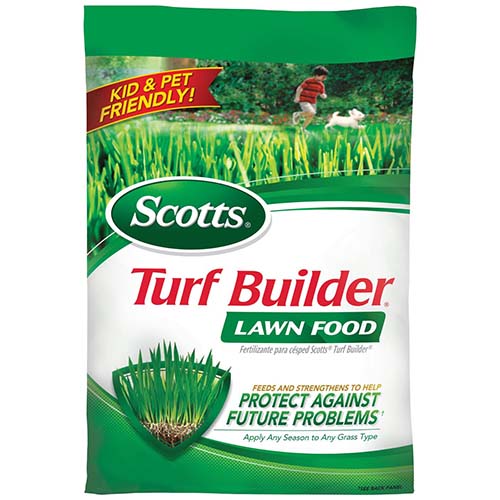
This lawn food from Scoots Turf has an NPK of 26-0-3. That means it doesn’t have phosphorous, so it’s best for older lawns that are already established. It also is great for any type of mature grass, in any geographic area.
One of the best benefits of Scotts Turf Builder is that it helps the grass to “bulk up” and thicken. That pushes out pesky and unsightly pests like crabgrass and weeds. Because of its high nitrogen content, it can strengthen grass considerably so you won’t have to worry about the weather – cold or drought—and its negative effect on your lawn.
This lawn fertilizer also can help promote the lawn’s ability to absorb nutrients and water. This is always a help because you’ll see bigger results, quicker. If you want fast-acting, strength-promoting fertilizer for your lawn, this is a great option.
Pros
- Helps to “bulk up” grass to thicken its density
- One of the best products to fight off weeds effectively
- Promotes nutrient and water absorption
Cons
- Limited to existing grasses due to no phosphorous
- Not recommended for dormant grasses
- No de-weeding contact
2. Miracle-Gro 1001834 Water Soluble 5lbs Lawn Food

The Water Soluble Lawn Food by Miracle-Gro is another lawn fertilizer that can work for a variety of different lawns. This one has an NPK of 36-0-6. Again, it is an effective option for mature grass that needs nutrients to thicken it up.
Because of its higher nitrogen count, it is also going to help with promoting lush and beautiful results in any lawn. This is specially formulated for turfgrass that has chelated iron and high nitrogen. Manufacturers state that results can be seen within a few days and you can thank its NPK for that.
If you have mature grass that needs some bulk, this is a great option. It is water-soluble and that gives it the ability to absorb into the root and the stalk of your grass, giving you a fantastic result.
Pros
- Effective with strengthening individual blades of grass
- Added iron ingredient helps promote greener results
- Very fast-acting
Cons
- Can easily burn lawn if not mixed precisely
- Can also burn if not applied just prior to the rain
- High-pollutant content
3. Simple Lawn Solutions Extreme Grass Growth Lawn Booster

The Simple Lawn Solutions Extreme Grass Lawn Booster is a good option for newer grass. Its NPK rating is 20-4-8, which means the phosphorous levels play to encouraging rooting. If you have a new lawn, the other metrics (nitrogen and potassium) will help to promote strength and pest-resistance.
On top of its NPK, this lawn fertilizer also is concentrated, but still pet-and kid-friendly. For families, this is a great option that is safe and all-natural. The ingredients are intense, but for households concerned about natural products, this is a great fit.
If you need a true lawn booster that promotes health but is also safe and natural, consider this grass growth lawn booster. Likely you’ll enjoy the results you get and quickly see how much this fertilizer can do for your home.
Pros
- Great option for new grass to start with
- Fulvic and humic acid-content act as building-blocks for new grass
- Truly boost grass and give quick and visible results
- Easy to use
Cons
- Doesn’t work for some type of grass
- Sprayer breaks easily
4. GreenView Lawn Food
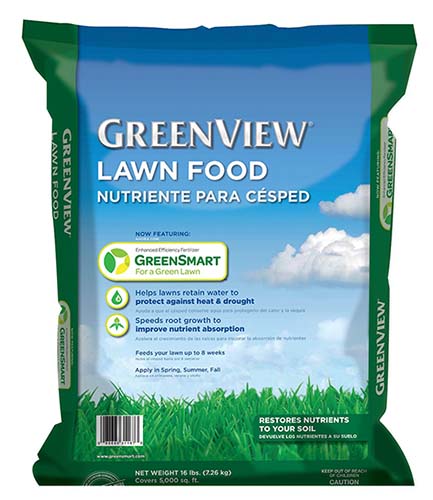
Another great option for older lawns is the GreenView Lawn Food. Its NPK is 22-0-4. It has a lot of nitrogen so it will help existing grass to flourish. If you’re looking to bulk up your grass, this is a perfect solution to do it. It has no phosphorous though, so it isn’t for new growth.
It is able to speed root-growth though. If you live in particularly harsh areas during winter, this can be a great addition to your plant’s lifespan. It gives plants a high durability so they can withstand the cold weather. It also promotes water retention in plants so if you live in a high-drought area, it may be a great option.
The other notable thing about GreenView is that it is time-released. That means that your lawn will reap benefits not only at the beginning of application but throughout the next few weeks. If you’re looking for a no-fuss but long-lasting fertilizer, this may be the perfect option.
Pros
- Super speed-root formula to strengthen
- Great for use at end-of-season to build strong cold-resistant grass
- Great for use in drought-heavy areas
Cons
- Must be applied with ample water or burning may occur
- Might not kill all weeds
- Not as effective as spray food
5. Milorganite 0636 Organic Nitrogen Fertilizer
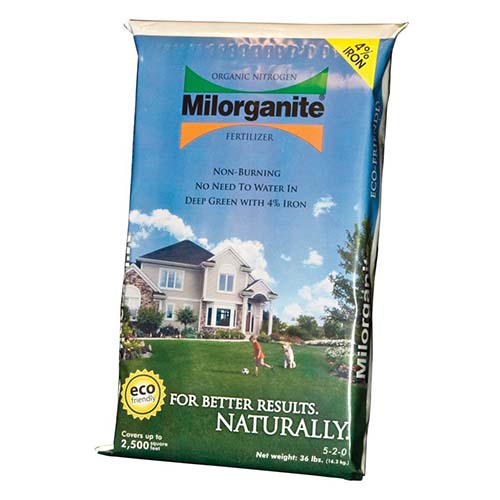
The Milorganic Organic Nitrogen Fertilizer is another top-rated organic selection for lawn fertilizer. For anyone with a family that has children and pets, this is a safe and effective way of building up lawn strength. It has an NPK of 5-2-0. That means it doesn’t have potassium. Because of this, it’s best for moderate temperatures with no danger of droughts.
Another attribute of this fertilizer is that it has a 4% iron that promotes a much-coveted lush and green look. For anyone who wants a lawn that is the envy of the town, this may be a huge help. It also can easily be used on shrubs, vegetables, and flowers.
Milorganite is an easily-applied year-round fertilizer that you can apply anytime. Its flexibility is another one of the things that makes it a great option. If you want to ensure that your plants have the food they need that is organic and safe, this is one viable solution in the market.
Pros
- Organic and safe for use if children and pets are around
- 4% iron contents promote lush greenery
- Flexible to use any time of the fertilizing season
Cons
- Can also burn if not applied just prior to rain/with enough water to dilute
- Not as effective as spray food
Our Top Pick for the Best Lawn Fertilizer

Our top pick for the best lawn fertilizer is the Simple Lawn Solutions Extreme Grass Growth Lawn Booster.
Extreme Grass Growth Lawn Booster from Simple Lawn Solutions stands out from the rest. Not only is it appropriate for established lawns, but it is also good for new lawns. This makes it one of the most well-rounded lawn fertilizers available.
Check the price on Amazon
